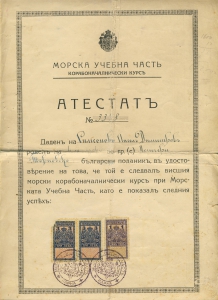
Челна страница от Зрелостното свидетелство (емисия тип “Указ”), издадено през 1924 г., на възпитаника на училището Тодор Делистоянов, впоследствие известен деятел в българското корабостроене.
In the period 1919-1920, the officer training course was not only successfully conducted but also the first graduates, pursuant to Decree of the Council of Ministers № 6/ 1.6.1920, were issued a certificate for completed higher specialized naval education „following the full curriculum of the Maritime Corps in Petersburg”. Diplomas of higher education were also issued to the participants in the preceding courses. Later the curriculum of this structure was significantly improved. In 1925 and 1928, based on the accumulated experience, two Shipmaster courses were formed, after taking which the trainees, after many years of theoretical and practical training, were issued diplomas for completed higher specialized naval education. Later some of them became prominent members of the Maritime Police Service (the official title under which the Bulgarian Navy existed under the terms of the Treaty of Neuilly-sur-Seine) and “master mariners” at the Bulgarian Commercial Shipping Company (the predecessor of Navigation Maritime Bulgare LTD)л

Титулната страница на атестат на Ангел Симеонов за завършено висше военноморско образование в Корабоначалническия курс при Морската учебна част, 1927 г.
Впоследствие Ангел Симеонов става изявен преподавател по корабоводене в Морско училище, автор на девет учебника, вкл. и на първия учебник на български език по електронавигационни прибори.
Under the terms of the peace treaty of Neuilly-sur-Seine, in the spring of 1921 His Majesty’s navy was disbanded. But a year earlier, the Engineering School was no longer subordinate to the War Ministry and was renamed Marine Engineering School. Practical parts of the training were conducted in the arsenals, on board ships, in electrical engineering classrooms, in telephone exchanges, in radio transmitter rooms, in power plants, in railway depots and workshops, on board the destroyers, in Bozhurishte, in the mines in Pernik and many other places. For a time the school was subordinate to the Ministry of Industry and Labor, and later – to the Ministry of Railways, Communications and Ports. Graduates could continue their studies in all tertiary technical institutions.
Practically, immediately after the end of the First World War, the Steersman School (unit), part of the Maritime Special Schools, was separated and transformed into Fisherman School, which existed until 1 April 1934.
In 1930, the Maritime Special Schools were reorganized and three new units were created: Electrical Engineering, Mechanical and Motor. Their programs (i.e. curricula) were supplemented and improved.
The Engineering School and Miner and Stoker School, later renamed Maritime Special Schools, were the first educational institutions in the country which not only trained hundreds of qualified specialists for the needs of the navy and the emerging Bulgarian industry. They became the backbone of the middle technical level personnel in the country.
In 1929, the status of the Marine Engineering School was set out in a special law and it was renamed Maritime School. Two years later a Seagoing Department was created, which was tasked with training watch officers for the merchant marine. The officers of the Maritime Police Service were trained partly in the Maritime School in Varna and graduated from the Military School in Sofia. The college in Sofia, which was a tertiary institution since 1923, issued their diplomas insofar as an officer needs to have college education and under the terms of the Treaty of Neuilly-sur-Seine Bulgaria was allowed to have only one military college.


